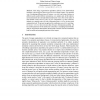Free Online Productivity Tools
i2Speak
i2Symbol
i2OCR
iTex2Img
iWeb2Print
iWeb2Shot
i2Type
iPdf2Split
iPdf2Merge
i2Bopomofo
i2Arabic
i2Style
i2Image
i2PDF
iLatex2Rtf
Sci2ools
DAGM
2004
Springer
2004
Springer
Adaptive Feature Selection in Image Segmentation
Most image segmentation algorithms optimize some mathematical similarity criterion derived from several low-level image features. One possible way of combining different types of features, e.g. color- and texture features on different scales and/or different orientations, is to simply stack all the individual measurements into one high-dimensional feature vector. Due to the nature of such stacked vectors, however, only very few components (e.g. those which are defined on a suitable scale) will carry information that is relevant for the actual segmentation task. We present an approach to combining segmentation and adaptive feature selection that overcomes this relevance determination problem. All free model parameters of this method are selected by a resampling-based stability analysis. Experiments demonstrate that the built-in feature selection mechanism leads to stable and meaningful partitions of the images.
Related Content
| Added | 01 Jul 2010 |
| Updated | 01 Jul 2010 |
| Type | Conference |
| Year | 2004 |
| Where | DAGM |
| Authors | Volker Roth, Tilman Lange |
Comments (0)

